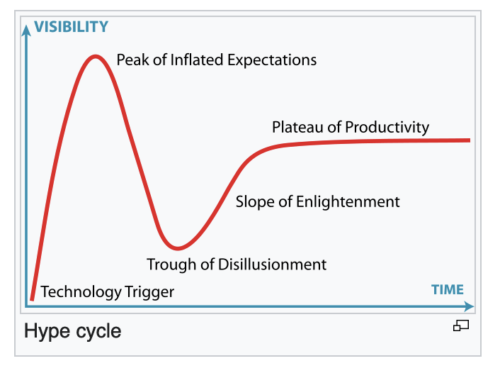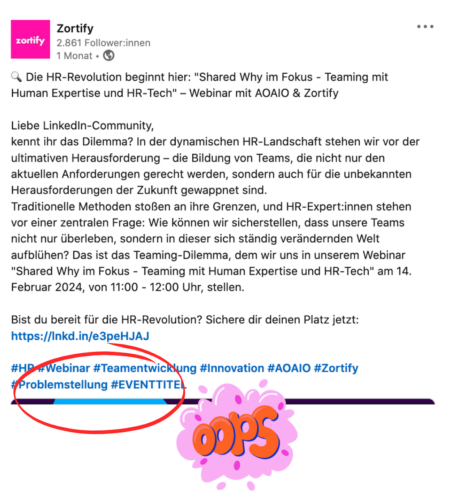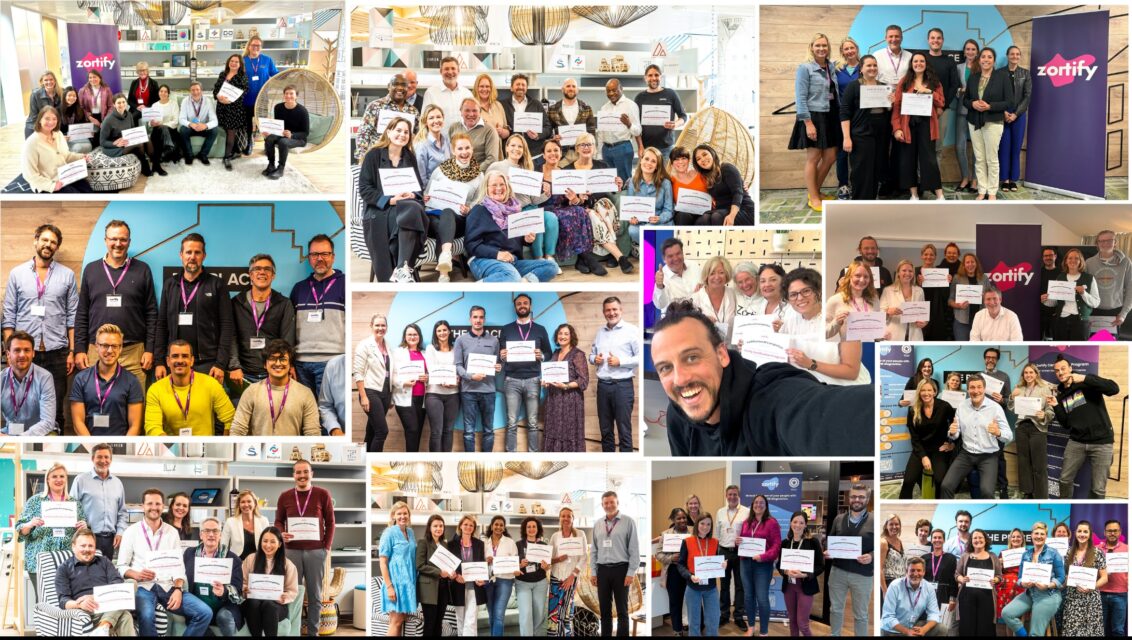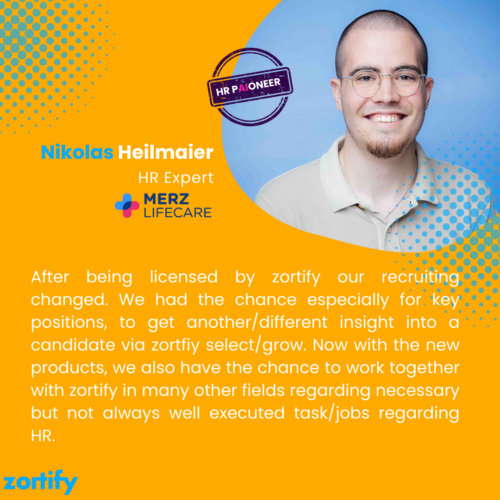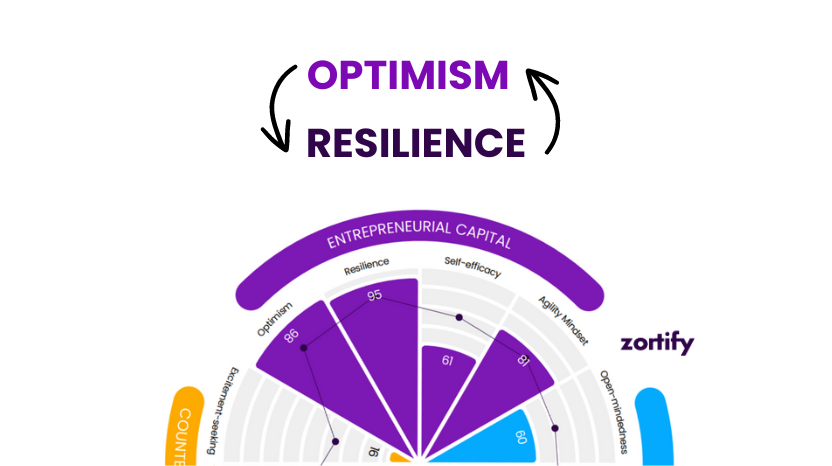Finding the right talent does not allow for compromises!
Applicants want a fast, appreciative application process. Companies, on the other hand, need a lot of information to prevent wrong hires, as well as efficient and structured processes to keep costs low and not make themselves liable to legal action. How does HR find the balance – and the best talent at the same time?
One thing is clear: a poor application process can be expensive. Specifically, when companies:
- hire candidates even though they don’t suit them,
- reject candidates who would actually be a good fit,
- lose candidates in the process because they are frustrated,
- risk their reputation due to recurring negative candidate experiences, resulting in bad reviews on Kununu or Glassdoor.
Where false judgements are made
Misjudgements happen, for example, when recruiters are overly impressed by features such as prestigious universities or large companies on a CV and then neglect to track down the really relevant qualifications. In interview situations, eloquence and self-confidence can mask a lack of skills.
Qualified candidates, on the other hand, run the risk of being weeded out early if their CV does not meet the formal requirements. Or if they sell themselves poorly in their cover letter. In stressful interview situations, introverted or less eloquent applicants sometimes perform worse. Even though they would be an excellent fit professionally.
Is AI the solution? – A clear “yes and no”.
The risk of bad hires does not automatically decrease with the use of AI. Sometimes the same effects described above are at work. AI systems can scan CVs and cover letters for certain keywords or qualifications in order to save time. However, this can lead to the exclusion of suitable applicants if unconventional but qualified candidates are overlooked due to missing keywords. At the same time, there is a risk of mis-hiring if applicants appear to be suitable due to the clever placement of keywords, even though they are not.
The same applies to AI-supported systems that analyze video interviews to evaluate non-verbal clues such as body language and facial expressions. Such systems would rate candidates positively simply because they show good non-verbal skills. At the same time, qualified people can fall through the cracks if they are assessed negatively due to nervousness or cultural differences in their non-verbal communication.
Taking the candidate’s perspective
So what to do? – One thing is clear: the best formal recruitment process is useless if it ignores the needs of the applicants. There are studies on what candidates want in the application process. First and foremost: objectivity, transparency, speed and personal interaction. Whether AI systems can have a positive impact on these factors is assessed differently by potential applicants, according to a survey of 1,005 participants conducted by the International University of Applied Sciences Erfurt. The majority of participants stated that the use of AI could lead to an increasingly impersonal process. More than half feared being disadvantaged by programming errors. And over 40 percent believe that transparency and data protection are at risk.
It is interesting to see that the majority of respondents have not knowingly had any experience with AI in the application process. The proportion of supporters also varies greatly depending on their level of education and migration background. For example, people with a high level of education or migration backgrounds are more likely to see advantages in AI, especially with regard to non-discriminatory assessment. In addition, some of the statements in the study clash with the desire for objectivity formulated in other studies. For example, 59% stated that they feared that factors such as “likeability” would be pushed into the background. At the same time, likeability is anything but objective and says little about the expected professional performance.
What can recruiters conclude from these contradictions?
Here comes the ultimate recruiting recipe!
No, of course not. At least we haven’t found it yet. (But we’re working on it with Zortify.) 🤓
Our findings from seven years of working at the interface of HR and AI:
- Walk the Talk: We can recommend to anyone and everyone to put themselves in the target group’s shoes and go through their own processes from an applicant perspective. Ask yourselves: How do I feel at the various stages of the process? Do I know what is happening and with what goal? Am I interacting with an AI or a human being? Would I still want to do the job after this experience?
- Transparency requires clarification: Where AI is used, it is all the more important that HR experts make personal contact with applicants at critical points. For example, to explain where AI technology is used, what kind of evaluation it provides and what happens next. De-briefings and a personal meeting in the event of a rejection are also important to maintain the bond between the company and candidate.
- Focus on individualization: Not every applicant has the same needs. While some applicants prefer a quick process, others want deeper insights into the company. Flexible application options, e.g. video interviews or trial days, can cater to both sides. The same applies to vacancies and roles: Not every job requires the same depth of information. For example, the application process for a management position can be designed differently than for an employee in production.
- Data-based evaluation: In order to improve the candidate experience based on data, companies should regularly gather feedback from applicants (including rejected applicants) to identify bottlenecks or points of frustration. Think: candidate experience surveys. Other KPIs can also provide valuable insights, such as those that measure the performance of newly hired employees or figures on how long new employees stay with the company.
- Reflect on your own thought and behavior patterns: Narratives such as the “talent vs. employer market” consciously or unconsciously shape the work of recruiters. Ask yourself self-critically: Do I always make quick decisions because I’m afraid of losing the applicant? Do I make compromises because I assume I won’t find a better candidate? – Becoming aware of your inner drivers helps to sharpen your focus on what the company really needs.
Conclusion: Hire slow, fire fast.
Candidate experience and business needs don’t have to be opposites – at best, they complement each other. Every recruiter has a responsibility for the company.
Even if the application process takes longer as a result, it is worth weighing up all the options carefully. AI systems can provide valuable insights, but the final decision should always be made by a person – or rather a group of people – with expertise.
In the short term, it may be tempting to hire a candidate, even if he or she is not an ideal fit – but in the long term, such a compromise will harm the company.
If a suitable candidate cannot be found immediately, freelancers, external experts or consultants can be a valuable alternative. Platforms such as ExpertPowerHouse, Upwork or Empion offer access to an expanded talent pool and make it possible to flexibly bridge short-term bottlenecks.
And last but not least: Fire fast. What may sound harsh is actually a deeply human move. After all, it serves no one’s interests to keep employees and give them the same negative feedback over a long period of time. What’s more, a bad hire puts a strain on the entire team. And: the world does not need more dysfunctional companies. But vibrant and innovative organizations that develop great solutions in a changing world. And that is much more likely with the right people in the right positions.
We look forward to your thoughts on this: Which levers are you already using successfully to ensure a good candidate experience and sound talent selection? – Join the discussion on LinkedIn.
Prof. Dr. Florian Feltes
Prof. Dr. Florian Feltes is co-founder and co-CEO of zortify and a forerunner in AI-supported HR innovation. Together with his team, he develops intelligent personality diagnostics and helps companies identify the perfect candidates—without expensive assessments and without bias. His vision: a world in which every company can effortlessly form high-performance teams and create work environments that allow human potential to flourish.
New Leadership: Nice is the little brother of toxic.
We think it is right and important that we as a society discuss topics such as “toxic masculinity” and clearly name corresponding misconduct as such. Language shapes our being and our consciousness; We can only describe problems and thus make them discussable if we have words for them. Toxic is such an important word.
Expensive, unloved employees: How to avoid bad hires
The start of the year traditionally brings movement into the company. Employees leave, others have to fill the gap, and new employees have to be found and trained at the same time. And the question always arises: How do we ensure that the next person really fits in with us? That they won’t leave for new shores at the next full moon or turn of the year?
More Evolution, Less Disruption: 5 tangible HR trends
For companies, 2025 means less disruptive change and more evolutionary growth. In view of the overall social situation, especially with the rise of populism, the pressure is increasing not only economically, but also in interpersonal relationships. This is where companies need to take a closer look. It is more important than ever to fill key positions with people who …
New Leadership: Nice is the little brother of toxic.
We think it is right and important that we as a society discuss topics such as “toxic masculinity” and clearly name corresponding misconduct as such. Language shapes our being and our consciousness; We can only describe problems and thus make them discussable if we have words for them. Toxic is such an important word. Toxic behavior has a negative effect on many levels and we need levers to recognize it and counter it.
At the same time, I advocate using words wisely. Not to spare those who behave wrongly. On the contrary: not to take away the weight of the words.
Toxic employees and toxic executives are a huge problem for companies. Researchers at the University of Bielefeld, the Berlin School of Economics and Law and the University of Trier have found that toxic leadership behaviour (“abusive supervision”) occurs in 85% of companies. 21 percent of companies even have a highly toxic atmosphere. The effects range from lower performance to a high level of sick leave to high employee turnover and the resulting low employer attractiveness.
But how do you actually know if a manager is behaving toxically?
It is clear that not everything that is uncomfortable is automatically toxic. A toxic working atmosphere can be recognised, for example, by the following factors:
- Manipulation & fear culture: Managers play employees off against each other and fuel a climate of uncertainty and fear.
- Lack of respect & appreciation: Superiors behave disrespectfully, make inappropriate remarks, hang mistakes high and at the same time let successes fall under the table.
- Unfair or arbitrary decisions: Rules only apply to some and personal sympathies determine the career path.
- High sick leave & high fluctuation: A conspicuous number of employees want to change internally in order to evade the manager, are sick more often or leave the company because the climate is unbearable.
Managers don’t have to be nice
What is the opposite of toxic? – It is certainly not “nice”. A strong leader should not primarily be nice, but first and foremost empathetic and effective. I would even go so far as to claim that overly nice behavior can promote a toxic working atmosphere to a certain extent.
How?
Managers who confuse new leadership with being nice all the time sometimes try to maintain harmony at any cost, avoid conflict and are reluctant to say “no”. In the short term, this niceness feels pleasant, but in the long term it leads to serious problems:
- Unclear expectations: A lack of hard necessary feedback leads to uncertainty.
- Drop in performance: Employees are not challenged and therefore not encouraged.
- Inequity in the team: Weaker employees are spared while high-performers feel frustrated.
- Loss of credibility and laissez-faire: Those who cannot assert themselves lose respect. At some point, everyone does what they want and nobody does what they should.
The psychology behind too nice leadership
Why do some managers behave too nicely? – There are usually psychological reasons behind this. Humans are fundamentally social beings and strive for connection with others. This is actually good and, if used correctly, can promote an empathetic leadership style. Sometimes, however, there is another need that makes good leadership difficult: the need to be liked. This can interfere with factual decisions and often leads to managers postponing conflicts instead of addressing them, so that they continue to smoulder, poison the atmosphere in the team and reduce performance.
What constitutes effective leadership?
Good leadership, on the other hand, means being “tough” in the best sense of the word – namely honest, clear and consistent. Managers must be “legible”. For example, we advise everyone who joins a team from outside to give employees the opportunity to make appointments in which they get to know and read the manager. This way, employees know what to expect. In contrast to laissez-faire managers, effective managers express clear expectations and make difficult decisions, even those that don’t please everyone. A consistent manager sets standards, demands performance and gives feedback – even if this is sometimes uncomfortable. Consistency is not the same as toxicity. Toxic behavior is based on humiliation, micromanagement, incapacitation and fear – consistent leadership, on the other hand, is based on clarity, fairness and reliability.
Toxic or Consistent – Telling the Difference
Sometimes it is not easy to recognize whether a behavior is toxic or necessary, even if it causes resistance among individuals. Especially when there is repeated friction between managers and employees on certain topics. The following questions can help to evaluate the other person’s behavior:
- Question emotional reaction: Do I feel personally affected because I don’t like something, or is my supervisor’s behavior really destructive?
- Judging according to objective criteria: Is the decision made justified, even if it does not necessarily follow my arguments?
- Obtain feedback: How do other colleagues experience the manager’s behavior? Do they share my feelings?
- Corporate culture: Are there values and structures that enable collaborative and appreciative work?
Conclusion: A more conscious approach to toxic personality traits
Toxic employees are a major problem and can be very expensive for companies. Ideally, people with toxic behavior should not even make it onto the shortlist for important positions. AI-based personality tests can be used to identify such tendencies as early as the application process and avoid bad hires. At the same time, we need a differentiated view of human characteristics. Not all characteristics that appear “hard” to others are also toxic. Here, AI systems can also help to recognize nuances and assess the personality traits of (potential) employees and managers scale-based.
The inflationary use of the term “toxic”, on the other hand, dilutes the real problem of toxic work cultures. Only if we clearly identify the difference can we seriously combat problems and at the same time value good leadership.
Prof. Dr. Florian Feltes
Prof. Dr. Florian Feltes is co-founder and co-CEO of zortify and a forerunner in AI-supported HR innovation. Together with his team, he develops intelligent personality diagnostics and helps companies identify the perfect candidates—without expensive assessments and without bias. His vision: a world in which every company can effortlessly form high-performance teams and create work environments that allow human potential to flourish.
Expensive, unloved employees: How to avoid bad hires
The start of the year traditionally brings movement into the company. Employees leave, others have to fill the gap, and new employees have to be found and trained at the same time. And the question always arises: How do we ensure that the next person really fits in with us? That they won’t leave for new shores at the next full moon or turn of the year?
Year 2 Post-GPT: How My Year Was Shaped and Why Work Must Remain Human
December 2024 – or, in the new chronology, Year 2 Post-GPT – marking two years since the go-live of the first version of ChatGPT. Requests like “Write a rhyming speech for my aunt Hannelore’s 60th birthday” or “Draft an outline for a whitepaper on the impact of generative AI on talent acquisition”.
More Evolution, Less Disruption: 5 tangible HR trends
For companies, 2025 means less disruptive change and more evolutionary growth. In view of the overall social situation, especially with the rise of populism, the pressure is increasing not only economically, but also in interpersonal relationships. This is where companies need to take a closer look. It is more important than ever to fill key positions with people who …
Expensive, unloved employees: How to avoid bad hires
The start of the year traditionally brings movement into the company. Employees leave, others have to fill the gap, and new employees have to be found and trained at the same time. And the question always arises: How do we ensure that the next person really fits in with us? That they won’t leave for new shores at the next full moon or turn of the year?
Not everything that makes employees change jobs is in the company’s control. But a lot. Above all, they can do a lot to avoid expensive bad hires. And to always know what employees are concerned about and what they want. It’s time-consuming, but it’s worth it. A look at the costs that a bad hire can entail clearly shows this. For employees without a management position, these can run into tens of thousands of euros. For managers, companies quickly end up with costs in the mid six-figure range.
How do these costs come about?
Let’s assume a Chief Sales Officer (who we will also have on board from February – shoutout to Jan). The salary range for such a position is between €8,000 and €20,000 gross per month, depending on the region and company size.
In order to find this person, costs arise for job advertisements. Possibly headhunters (whose fees are based on the profile sought, so are correspondingly high for managers), job interviews, contract preparation and the equipment of the workplace.
This is followed by the familiarization phase. During which neither the new employee nor their team can perform to their full potential. Agreements take longer, processes have to be explained and familiarized. And both sides need time to get used to each other. According to studies, the break-even point, at which the costs and benefits of the new employee equalize, is reached after six months at the earliest. It can take up to two years to reach full productivity. Provided the new colleague fits in well with the team.
If the recruitment is successful, the cost of the new hire is already around the same amount as the employee’s annual salary.
And suddenly everyone realizes: he’s no good at all.
The new colleague’s performance falls far short of expectations, communication with colleagues doesn’t work, the tone is harsh, the team is demotivated, sick leave increases. At this point at the latest, companies can start to add up the costs that arise because the other team members feel uncomfortable, insecure or frustrated. If there is a lack of psychological safety in the team, which is largely based on good leadership, new ideas fail to materialize. Employees are sick more often and those who are there are increasingly stressed because they not only have to take on the tasks of their absent colleagues. But also have to compensate for the lack of leadership from the new colleague. In the worst case scenario, employees leave the company while the incompetent manager remains on board.
The effects go even further: customer satisfaction and the company’s image can also suffer massively as a result of poor hiring. Here too, studies show that the costs can run into the tens of thousands.
Trying to sit it out can also be costly for companies. In a survey, 30% of companies stated that they had held on to employees for between three and six months. Even though they clearly did not fit into the team. With all the negative (and expensive) consequences for the rest of the team, motivation and productivity.
If companies then reach the point of letting go of the unpleasant employee (or promoting them, as in elephant graveyard), further costs arise – for compensation payments, further and, in case of doubt, even higher salary payments (in the case of promotion) and the permanently disrupted team dynamic (here too: this can be permanently impaired in the case of promotion). At the same time, the search for a candidate starts all over again – with the costs mentioned above.
Phew.
If companies don’t have a huge ‘bad hire budget’, they need ways and means to avoid expensive bad hires at all costs. What can these be?
Personality first, skills second: Skills can be learnt, personality is there. AI-based diagnostics can be used to identify and cluster the key personality traits for the company. Without the need for time-consuming assessment centers.
Thoroughly test high potentials too: Years of management experience, top performance on paper and the right first impression. However, this should not stop HR from taking a close look at people with management ambitions in particular. A personality analysis provides insights that go far beyond first impressions and makes desired behavior visible as such. It is also worth talking to former colleagues and superiors about how they worked together.
Know your own bias and minimize it: There are more than 13 types of bias that influence our decisions in favor of or against a person. Anyone involved in the selection of candidates should be aware of those prejudices – and consciously try to overcome them. Technology can also help here. And provide an objective assessment of the person before the next step in the application process.
Prof. Dr. Florian Feltes
Prof. Dr. Florian Feltes is co-founder and co-CEO of zortify and a forerunner in AI-supported HR innovation. Together with his team, he develops intelligent personality diagnostics and helps companies identify the perfect candidates—without expensive assessments and without bias. His vision: a world in which every company can effortlessly form high-performance teams and create work environments that allow human potential to flourish.
13 + 1 Bias in Recruiting: How to Recognize and Overcome Them to Find Truly Suitable Candidates
Bias – unconscious thought patterns – can influence our perceptions and decisions. In the context of recruitment, bias can result in unfair evaluations of candidates, leaving potential untapped. This guide outlines common bias, their impact, and strategies to avoid them.
Year 2 Post-GPT: How My Year Was Shaped and Why Work Must Remain Human
December 2024 – or, in the new chronology, Year 2 Post-GPT – marking two years since the go-live of the first version of ChatGPT. Requests like “Write a rhyming speech for my aunt Hannelore’s 60th birthday” or “Draft an outline for a whitepaper on the impact of generative AI on talent acquisition”.
More Evolution, Less Disruption: 5 tangible HR trends
For companies, 2025 means less disruptive change and more evolutionary growth. In view of the overall social situation, especially with the rise of populism, the pressure is increasing not only economically, but also in interpersonal relationships. This is where companies need to take a closer look. It is more important than ever to fill key positions with people who …
More Evolution, Less Disruption:
Five Tangible HR Trends to Get Started Right Away
For companies, 2025 means less disruptive change and more evolutionary growth. In view of the overall social situation, especially with the rise of populism, the pressure is increasing not only economically, but also in interpersonal relationships. This is where companies need to take a closer look. It is more important than ever to fill key positions with people who can cope with the increasing demands both professionally and personally. AI can help with this.
1. Building Resilient Mid-Level Leaders
Many people are starting the new year potentially overwhelmed. According to a Gartner survey, three-quarters of HR managers feel overburdened by the expanding range of their responsibilities. The development of middle management often gets neglected, yet mid-level leaders are crucial in initiating, communicating, and supporting necessary innovations.
Therefore, in 2025 companies should focus more on developing leadership skills. AI technologies can support this by analyzing specific traits such as entrepreneurial thinking, resilience, or optimism in employees, and deriving targeted learning and development programs.
2. Investing in Long-Term HR Tech
More than half of HR leaders report that current technologies do not meet today’s or future requirements. The focus should not just be on efficiency but on supporting HR staff in their development.
A shift in thinking is needed: investments in smart technologies should aim to strengthen the transformative role of HR. The Gartner Hype Cycle shows that technologies go through various phases before they can be productively utilized.
Realistic management of these phases helps in setting expectations and developing sustainable solutions.
Gartner Hype Cycle
Currently, many companies are still between phases 2 and 3. Expectations for AI-powered tools are both highly positive and negative. At the same time, it is becoming increasingly apparent that AI alone does not offer a comprehensive solution. While this may disappoint some, it presents an opportunity for HR professionals whose task is to identify and foster human potential. They can skip the “trough of disillusionment” and proceed directly to the “slope of enlightenment.”
However, support from number-driven stakeholders is crucial. Investors and decision-makers must be willing to invest not only in time and cost savings but also in transformative technologies and learning and development programs for HR staff.
3. Cultural Change Bottom-up – With Change Influencers
Top-down mandated innovations often face resistance and contribute to “change fatigue.” After disruptive changes, it is essential to allow time for evolutionary stabilization. New things must “restabilize, lose their surprise effect, and normalize,” as sociologist Armin Nassehi puts it regarding successful societal change processes.
In a corporate context, “change influencers” can help foster changes. These employees with strong peer networks drive innovations forward. AI-powered tools can help identify them.
In this context, we highly recommend the Ada Fellowship Program.
Small, easily implementable technologies (“tech nuggets“) can also facilitate change and establish new work practices.
4. AI Competencies Become Mandatory – And Soft Skills Are Not Just Optional
Starting in 2025, the EU AI Act will require companies to ensure that employees using AI systems possess the necessary competencies. As technology becomes more embedded in HR work, HR departments will increasingly depend on other disciplines within the company, such as data protection, IT, legal, work councils, or procurement. The first three will become even more involved in assessing the potential risks of AI. Companies must therefore rethink their processes and consider how to implement AI tools to take on truly business-critical tasks. Ideally, they will have a provider that supports them and ensures that the systems are used in compliance with EU regulations.
Alongside technical knowledge, fostering soft skills remains crucial. As technology increasingly shapes our daily lives, reflecting on our interactions with it becomes more important. What behaviors do we want to maintain? What should we let go of? What new ones should we establish?
5. Addressing the Skilled Worker Shortage: Strengthening Employees Instead of a Four-Day Work Week
The shortage of skilled workers is real. The craft sector alone currently lacks 113,000 skilled workers. However, companies are not merely wish-fulfillers. A four-day work week will not be feasible for most companies in 2025. Instead, they need to focus on how to achieve significant results with the existing workforce without burning them out. Here, psychology is also important, especially traits like resilience, optimism, and self-efficacy, which can be measured using AI.
Moreover, we need a shared understanding that work does not always mean joy but also involves growth and overcoming challenges. Conflicts are inevitable. What matters is how they are handled – whether people engage with each other respectfully and constructively even in difficult phases. There is no such thing as a “perfect organization” or a “perfect employee.” The acknowledgement of contradictions and simultaneity within an organization is crucial.
Ideally, the tools used should also consider this complexity. Instead of quickly categorizing people, they should aim to view all aspects of a personality in a differentiated manner and derive suitable roles and development opportunities for employees.
Conclusion
It will be a challenging year, but we remain optimistic. Despite external pressures, companies have many areas within their control, such as whom they hire and promote, how they collaborate, how they support their employees, and how they use the scarce “resource” of human potential effectively. Integrating AI technology offers enormous opportunities but requires a shift in thinking and learning at all levels – from leadership development to fostering soft skills to creating a supportive, encouraging, and demanding corporate culture. It is crucial for companies to focus not only on efficiency but on sustainable development and transformation skills, enabling people to adapt to new, challenging situations and use technology meaningfully.
Prof. Dr. Florian Feltes
Prof. Dr. Florian Feltes is co-founder and co-CEO of zortify and a forerunner in AI-supported HR innovation. Together with his team, he develops intelligent personality diagnostics and helps companies identify the perfect candidates—without expensive assessments and without bias. His vision: a world in which every company can effortlessly form high-performance teams and create work environments that allow human potential to flourish.
13 + 1 Bias in Recruiting: How to Recognize and Overcome Them to Find Truly Suitable Candidates
Bias – unconscious thought patterns – can influence our perceptions and decisions. In the context of recruitment, bias can result in unfair evaluations of candidates, leaving potential untapped. This guide outlines common bias, their impact, and strategies to avoid them.
Between Trump, zero-motivation-days and the “Robin Hood of talent”
Donald Trump will be the next US president. And in social networks, the concept of paid “zero-motivation-days” is being discussed, that is days off for employees without them having to call in sick or take vacation days. Two topics, although of different dimensions, which for us lead to one conclusion: Companies must start to face their responsibility!
Hierarchy with AI rather than everyone at eye level?
Companies promote flat hierarchies and a culture at eye level in order to attract skilled workers. That sounds very progressive and good for employees at first glance. But why do so many people still leave the company after a short time? Why is retention, i.e. retaining talent in the organization, still one of the major challenges?
Year 2 Post-GPT: How My Year Was Shaped and Why Work Must Remain Human
Florian’s 2024 Review
December 2024 – or, in the new chronology, Year 2 Post-GPT – marking two years since the go-live of the first version of ChatGPT. Requests like “Write a rhyming speech for my aunt Hannelore’s 60th birthday” or “Draft an outline for a whitepaper on the impact of generative AI on talent acquisition” – OpenAI’s chatbot has become an indispensable tool for many since November 2022, serving as both collaborator and colleague. Imperfect yet always available, it helps tackle writer’s block or tight deadlines. This past year, we at Zortify leaned on ChatGPT again for tasks like crafting social media posts.
Sometimes, though, it’s not perfect, as we’ve seen. 😉
The best posts? They came from us—straight from the heart, prompted by passion.
Hyperfocus and Hyperteams, Thanks to AI
December 2024 also marks six years of Zortify and two years of unwavering focus on what we believe will have the greatest impact on modern HR practices: AI-driven HR diagnostics. Our goal is clear: achieve an unprecedented level of accuracy in recruiting and development. This means fewer mis-hires, more productive teams, and the right people in leadership positions.
This focus sparked significant internal changes – some positive, some challenging. Team members left, others joined. Leveraging our own technology, which offers personality diagnostics and objective insights, we’ve built a dream team. And we’re growing. If you’re considering a career change in 2025 – especially in Sales – get in touch!
The Bright Side of AI
In December 2024, many businesses are still stuck in the old era – 2022 pre-GPT. While AI adoption has grown this year, it’s mainly large corporations taking advantage of the new tools:
- 48% of large enterprises use AI, compared to
- 28% of midsized companies and
- 17% of small businesses.
For many, the main obstacle remains a lack of knowledge. Clearly, we’re still in the early stages of widespread AI adoption in the economy.
However, in social media, the story is different. Fake news and deepfakes have become so pervasive that they threaten democratic systems. It’s a stark reminder of AI’s power—unfortunately, in its darkest form.
On the bright side, AI is also enabling remarkable things:
- People relieved of tedious routine tasks,
- Candidates finding jobs that align with both their skills and personalities, and
- New, exciting roles emerging at the intersection of human and technological expertise.
Everyone wants these five colleagues* in 2024 (*or: this one AI)
While 2023 (Year 1 Post-GPT) focused on fears about job displacement, 2024 brought the realization that AI won’t replace humans in many areas; instead, it’s making human contributions more crucial than ever. Good work still hinges on collaboration – with other people and within diverse teams. It thrives on inclusion, objective analysis, and respecting individual uniqueness.
Looking ahead to 2025, the advance of AI will make the human element indispensable.
Why the Human Element Matters
1. AI Makes Human Expertise Absolutely Essential
In an age of ever-shorter innovation cycles, failing forward has become essential. Success lies in learning as we go, guided by those who are already a few steps ahead – those who’ve either learned from their mistakes or designed predictive models to avoid them.
At Zortify, we aim to be these forward-thinkers, guides, and shock absorbers for our clients. We teach the skills needed to use AI technology effectively, enabling businesses to focus on their unique challenges.
Incidentally, this is becoming a legal requirement in 2025. The EU AI Act mandates that employees working with AI possess adequate skills. With our certification program, we’re helping clients easily transition into this new era.
2. Culture Development Remains a Human Task
2024 has proved once more: culture first, AI second. Technology only succeeds within a supportive culture. Toxic work environments or outdated mindsets aren’t fixed by AI alone.
At Zortify, fostering a respectful and inclusive culture remains a core value. For me this includes taking on seemingly trivial tasks when necessary – whether it’s organizing meals for a certification event or stepping in to fill an unexpected gap.
At the same time, in view of our realignment and the associated changes since 2023, it was important to me to highlight and celebrate the achievements of our team. A good example of this and an absolute highlight in 2024 was our Zortify Connect Day, celebrating both our clients and our team. Hearing clients openly share their positive experiences with us was a testament to our team’s efforts and a major motivator.
There will also be a CONNECT Day in 2025. Pre-Registration has already started.
3. Leadership Requires Human Intuition, Clarity – and Free Calendar Time
Good leadership remains inherently human. It’s about knowing when to guide, when to step back, and when to empower team members. AI-based diagnostics can help identify and develop leaders with these qualities but cannot replace the human touch.
In 2024, I focused intensely on saying “no” to distractions, ensuring alignment with our priorities. This required clear communication – an area I worked to improve by preparing more thoroughly for meetings and fostering dialogue through active listening.
In my view, active listening remains the number one leadership skill. AI can support this, for example by identifying socially desirable behavior as such and providing insights that go beyond first impressions and the obvious. However, it is no substitute for an open door and an open ear policy fostered by leaders. Personally, I have consciously taken more time for feedback and review meetings in the past year and invested in our corporate culture.
An example of that was the implementation of “Open Calendar Time” on office days for spontaneous conversations and personal exchanges. These moments strengthened collaboration and trust within our team.
Conclusion
AI profoundly shaped our lives and work in 2024. In 2025, even more businesses and individuals will harness its potential. Still, collaboration will remain fundamentally human. Successful HR departments will blend deep AI expertise with the empathy and nuance that only humans can provide, using technology to elevate their impact.
At Zortify, we’re proud of our progress in 2024 – thanks to our amazing team. As the year ends, I’m filled with gratitude and excitement for the connections we’ll forge in 2025.
Happy Holidays!
Prof. Dr. Florian Feltes
Prof. Dr. Florian Feltes is co-founder and co-CEO of zortify and a forerunner in AI-supported HR innovation. Together with his team, he develops intelligent personality diagnostics and helps companies identify the perfect candidates—without expensive assessments and without bias. His vision: a world in which every company can effortlessly form high-performance teams and create work environments that allow human potential to flourish.
13 + 1 Bias in Recruiting: How to Recognize and Overcome Them to Find Truly Suitable Candidates
Bias – unconscious thought patterns – can influence our perceptions and decisions. In the context of recruitment, bias can result in unfair evaluations of candidates, leaving potential untapped. This guide outlines common bias, their impact, and strategies to avoid them.
Between Trump, zero-motivation-days and the “Robin Hood of talent”
Donald Trump will be the next US president. And in social networks, the concept of paid “zero-motivation-days” is being discussed, that is days off for employees without them having to call in sick or take vacation days. Two topics, although of different dimensions, which for us lead to one conclusion: Companies must start to face their responsibility!
Hierarchy with AI rather than everyone at eye level?
Companies promote flat hierarchies and a culture at eye level in order to attract skilled workers. That sounds very progressive and good for employees at first glance. But why do so many people still leave the company after a short time? Why is retention, i.e. retaining talent in the organization, still one of the major challenges?
13 Bias in Recruiting
How to Recognize and Overcome Them to Find Truly Suitable Candidates
Bias – unconscious thought patterns – can influence our perceptions and decisions. In the context of recruitment, bias can result in unfair evaluations of candidates, leaving potential untapped. This guide outlines common bias, their impact, and strategies to avoid them.
1. Confirmation Bias
This occurs when we seek information that confirms our initial impressions. For example, during an interview, we might look for signs that affirm our positive or negative first impressions of a candidate.
How to overcome it:
- Develop standardized interview questions.
- Involve multiple interviewers to balance subjective views.
- Use AI tools for an objective initial assessment.
2. Halo Effect
A single positive trait (e.g., confidence) influences our overall impression of a candidate, making other traits seem better than they might actually be.
How to overcome it:
- Identify critical traits for the role in advance.
- Use AI to conduct personality analyses before interviews.
- Evaluate each competency independently.
3. Similarity Bias
We tend to favor people similar to ourselves in terms of background, values, or interests. This is often masked as “cultural fit” but can lead to unconscious discrimination.
How to overcome it:
- Focus on objective role requirements rather than similarities.
- Ensure a diverse HR team is involved in decision-making.
4. Stereotyping
Stereotyping occurs when we make hiring decisions based on external characteristics such as gender, origin or age. Our judgments are often based on unconscious assumptions (unconscious bias) and not on facts.
How to overcome it:
- Conduct anonymized application processes.
- Cultivate a culture of ongoing critical reflection on unconscious bias.
- Penalize overtly discriminatory behavior.
5. Anchoring Bias
The anchor bias refers to the fact that first impressions or initial responses can have a disproportionately large influence on our overall assessment of a candidate.
How to overcome it:
- Use data-driven tools to form a comprehensive view of candidates.
- Make decisions only after collecting and reviewing all relevant information as a team.
6. Attribution Error
When we succumb to the attribution error, we immediately attribute certain behaviors to a candidate’s personality instead of to external circumstances. For example: “They are disorganized” instead of “They didn’t have enough time to prepare.”
How to overcome it:
- Always consider the context behind behaviors or statements.
- Ask candidates about the reasons behind their actions (“Was the preparation time adequate?”).
- Use NLP-based tools to create objective personality profiles.
7. Recency Bias
In the case of recency bias, the most recent impressions or answers of the person in front of us have a greater influence on our perception than others. We often ignore what was said earlier.
How to overcome it:
- Use standardized digital question tools before interviews.
- Leverage NLP technology to analyze open-text responses for personality insights.
- Systematically reflect on the overall impression as a team.
8. Overconfidence Bias
Relying too heavily on personal judgment and making quick conclusions (“I can spot a great salesperson instantly”).
How to overcome it:
- Have your evaluations reviewed by others, combining human and AI input.
9. Horns Effect
The opposite of the Halo Effect, where a single negative trait taints the overall perception of a candidate.
How to overcome it:
- Reflect on whether your negative judgment is based mostly on one trait.
- Take time for a comprehensive evaluation.
- Support decisions with objective data about the candidate’s personality.
10. Availability Heuristic
The availability heuristic describes how we are sometimes overly influenced by experiences or memories from the recent past. This can be, for example, conversations with other applicants that have just taken place.
How to overcome it:
- Schedule interviews with breaks in between.
- Incorporate data-driven evaluations of candidates’ skills and attributes.
- Document impressions from each interview to mitigate post-hoc bias.
11. Status-Quo Bias
With a status quo bias, preference is given to candidates who align with established patterns. New approaches or unconventional profiles are often being overlooked.
How to overcome it:
- Assess not just skills but also personality.
- Actively seek out candidates with atypical CVs.
- Encourage openness and innovation within the team.
12. Survivorship Bias
Survivorship bias occurs when we focus on traits of successful (former) employees while neglecting the potential of other characteristics, not giving unusual or unknown profiles the chance they deserve.
How to overcome it:
- Identify which traits are truly critical for success in the role and organization.
- Evaluate candidates’ abilities independently of previous benchmarks.
13. Loss Aversion
Preferring the “safe” candidate to avoid risks, even if another might better fit the company culture.
How to overcome it:
- Consider the long-term benefits of bold decisions.
- Use trial tasks or AI-based assessments to reduce the risk of poor hires.
14. Social Desirability Bias (“Super Bias”)
Candidates may present themselves in ways they believe are socially desirable, masking their true skills or values.
Example: A candidate emphasizes in the interview how important teamwork is for her, although in reality she prefers to work independently. This is solely a statement to meet the interviewer’s expectations.
The social desirability bias is so powerful because it can reinforce other bias. For example, if a candidate behaves in a particularly socially desirable way, the halo effect or the anchoring bias could be amplified. A strongly self-confident candidate could not only be noticed positively, but other skills could also be overestimated – even though they may only be faking them.
How to overcome it:
- Use NLP technology for personality tests that analyze free-text responses, bypassing conventional cues.
- In interviews, ask about specific past situations (e.g., “Can you give an example of solving a team issue?”).
- Avoid giving hints about what you consider the “right” answer.
Conclusion
Biases are a natural part of decision-making but can have negative effects on both organizations and candidates. Through deliberate actions, standardized processes, continuous training, and the use of AI tools, we can counteract these distortions and make better hiring decisions. Recognizing these biases is the first step, followed by developing strategies to mitigate them. When human and artificial intelligence work together, the result is fairer hiring processes and finding the right people for the right roles.
Prof. Dr. Florian Feltes
Prof. Dr. Florian Feltes is co-founder and co-CEO of zortify and a forerunner in AI-supported HR innovation. Together with his team, he develops intelligent personality diagnostics and helps companies identify the perfect candidates—without expensive assessments and without bias. His vision: a world in which every company can effortlessly form high-performance teams and create work environments that allow human potential to flourish.
Between Trump, zero-motivation-days and the “Robin Hood of talent”
Donald Trump will be the next US president. And in social networks, the concept of paid “zero-motivation-days” is being discussed, that is days off for employees without them having to call in sick or take vacation days. Two topics, although of different dimensions, which for us lead to one conclusion: Companies must start to face their responsibility!
Hierarchy with AI rather than everyone at eye level?
Companies promote flat hierarchies and a culture at eye level in order to attract skilled workers. That sounds very progressive and good for employees at first glance. But why do so many people still leave the company after a short time? Why is retention, i.e. retaining talent in the organization, still one of the major challenges?
AI in HR: Overcome the fear, embrace the opportunities!
AI is neither all good nor all bad. Used correctly, it can improve the lives of many people in general and working life in particular. New opportunities are opening up in HR recruitment and development in particular, without people being ” sorted out ” or replaced by technology. Let’s take a look at what is important for a fearless, constructive and responsible approach to AI in HR.
Between Trump, zero-motivation-days and the “Robin Hood of talent”
Why companies urgently need a personality check
Donald Trump will be the next US president. And in social networks, the concept of paid “zero-motivation-days” is being discussed, that is days off for employees without them having to call in sick or take vacation days.
Two topics, although of different dimensions, which for us lead to one conclusion: Companies must start to face their responsibility! Responsibility for the people who work for them, but also for society as a whole. They need a straightforward “personality check” in order to find their role in these turbulent times, to develop new solutions that will secure their future, and to spark people’s enthusiasm for them as employers as well as for liberal, democratic societies, on whose existence their business success ultimately depends.
Here is our idea for an “assessment for companies” in these turbulent times.
1. Who do you want to be?
Beyond “New Work” buzzwords, ask yourself what you want to stand for, what contribution you want to make to this world, how you want to make life on this planet better and how you want to shape your organization in specific terms. Whether there will be zero-motivation days or not, one thing is clear: the hamster wheel is not an innovative place, as labor expert Hans Rusinek puts it. Journalist Sebastian Klein finds even more drastic words, raising the question of who wants to work in companies that operate under war-like conditions. Instead, we need a new definition of business success that goes beyond turnover and profit and includes responsibility for people, society and the environment.
Some of you may have already seen on Social Media (especially on LinkedIn) that the ‘School of Moral Ambition’ is currently forming as a new movement. This movement wants to specifically attract talent away from companies that exploit people and our planet. The people who engage in the School call themselves the ‘Robin Hoods of Talent’. Hundreds of people joined shortly after it was announced; well-known founders are promoting the initiative, which is likely to hit a nerve with many people these days.
Companies now need the courage to look in the mirror, make a consistent paradigm shift, challenge their own product range and present something new and better in terms of a future that is worth living.
2. How do you want to lead?
We quote Hans Rusinek once again, who says that the power of a boss is much more present for us than that of a state. Companies shape the people who work for them. Managers bear great responsibility, especially in times of great uncertainty, when many people are looking for supposedly simple solutions or longing for the “good old days”. It is up to leaders to provide orientation. They are the compass navigating through organizational change and upholding core values such as empathy, openness, respect and collaboration.
Dr Hans W. Hagemann of the Munich Leadership Group has found an easy-to-understand metaphor for this:
“Imagine you’re a parent driving through thick fog with your three small children in the back seat and you can’t see your hand in front of your eyes. Of course you’re scared. But you can deal with it by adjusting your speed, using the fog lights and paying extra attention. What about the kids? –You can of course tell them that you’re scared and that you’re prepared for a collision at any time. But as a consequence, you probably won’t be able to control the screaming in the back seats. Alternatively, you could point to the navigation system and tell them that there’s a petrol station five kilometers away where you can take a little break with popcorn. The situation is the same, you’ve told the truth, you’ve given guidance and you’re moving on. In the future, it will be a matter of dealing constructively with growing uncertainties.”
Speaking of leadership
Good leadership also involves creating an environment of psychological safety. To achieve this, the purpose and goals of the organization must be clear (see point 1). Instead of knowing all the answers, leaders should adopt a curious, questioning mindset. Be vulnerable in the best sense of the word in the spirit of ‘vulnerable leadership’. This includes listening to employees and providing a safe space for ideas and suggestions as well as criticism and concerns. ‘Failing forward’ is what it takes to achieve progress: try things out, fall flat, get up on your feet again and do better. However, this is only possible in an environment that thrives on appreciation and sincerity. It is up to leaders to promote such an environment.
HR market analyst Josh Bersin rightly says that of all HR investments leadership development creates the greatest value. Especially as leadership skills are no longer only required at the top of organizations, but are now needed at all levels considering the trend towards flat hierarchies in many companies. Selecting the right people for these key positions is more important than ever. We have conducted one of the largest studies on the subject of ‘narcissism’. It shows that young people today are more narcissistic than previous generations. This can become a problem when filling leadership positions in particular. Companies should be aware of that and use research-based and ethical personality tests to protect themselves.
3. What does it really mean to be productive?
Good leadership also comes with creating free time for employees to escape the hamster wheel and think in depth about good solutions. These free spaces, these phases of pondering, wondering and chatting at the coffee machine should be considered a valuable and natural part of doing the job. A walk with a colleague not only creates social contact (which in itself has a stabilizing effect on democratic structures), but also potentially constructive friction and therefore opportunity for new solutions. Doing the right thing can also mean doing nothing, pausing, reflecting and discarding instead of sitting in a meeting or building a PowerPoint presentation for a product that would turn out to be pointless on closer, unhurried inspection.
With such a new baseline regarding work ethics, the discussion about whether to ‘work harder’ or receive paid ‘zero motivation days’ becomes obsolete. Not to mention that a contemporary leadership style should include abolishing practices not worthy of adults, such as micromanagement and controlling every step of your employees.
Conclusion
In a society that at the moment is characterized by frustration, fear and resignation to worrying proportions, we need companies that create a ‘climate of courage’. Companies that set new standards in how we negotiate and shape the future with a spirit of innovation and empathetic leadership. More and more well-qualified people are very likely to opt for such organizations if they have the choice. Now is the time for companies to look in the mirror and do their very own personality check. No more sugar coating and greenwashing. Now is the time for real responsibility.
Check out the full interview with Hans W. Hagemann about leadership qualities and how to find them in employees.
Prof. Dr. Florian Feltes
Prof. Dr. Florian Feltes is co-founder and co-CEO of zortify and a forerunner in AI-supported HR innovation. Together with his team, he develops intelligent personality diagnostics and helps companies identify the perfect candidates—without expensive assessments and without bias. His vision: a world in which every company can effortlessly form high-performance teams and create work environments that allow human potential to flourish.
Hierarchy with AI rather than everyone at eye level?
Companies promote flat hierarchies and a culture at eye level in order to attract skilled workers. That sounds very progressive and good for employees at first glance. But why do so many people still leave the company after a short time? Why is retention, i.e. retaining talent in the organization, still one of the major challenges?
AI in HR: Overcome the fear, embrace the opportunities!
AI is neither all good nor all bad. Used correctly, it can improve the lives of many people in general and working life in particular. New opportunities are opening up in HR recruitment and development in particular, without people being ” sorted out ” or replaced by technology. Let’s take a look at what is important for a fearless, constructive and responsible approach to AI in HR.
Employee analysis with AI: Make transparent what makes us transparent!
How much transparency is good for people and companies? – In times of Artificial Intelligence, the question of transparency has come back into focus. While we had slowly become accustomed to moving through the analogue and digital world as “transparent people”, the question of how transparent people and processes may, should and must be takes on new relevance due to the increased use of AI.
Hierarchy with AI rather than everyone at eye level?
Companies promote flat hierarchies and a culture at eye level in order to attract skilled workers. That sounds very progressive and good for employees at first glance. But why do so many people still leave the company after a short time? Why is retention, i.e. retaining talent in the organization, still one of the major challenges? Why are there still more Stefans and Christians in German boardrooms than women? And can AI help to change things?
I think organizations need to be aware of three things:
- Flat hierarchies don’t eliminate the imbalances of power. Instead, they make them more difficult to grasp. They lead to power no longer unfolding on the basis of a fixed position, but finding its way more subtly. Through certain personality traits, for example, through the appearance, success or knowledge advantage of individuals.
- A culture at eye level can be an advantage for some employees and exclude others. The question is: who is on an eye-level with whom? A workforce of people with the same background, the same ethnicity, the same skin color, the same socialization is very likely to hold the same biases – consciously or unconsciously – against people who don’t fit in.
- In order to change organizational cultures, the structures must also change, i.e. the organizational framework: Processes, rules, sanctions, communication channels and criteria for selecting people to work in management positions.
How can AI technology make a difference here?
In order to change organizations and make them more attractive to many skilled workers (sidenote: by creating suitable conditions for parents and especially mothers, 840,000 vacancies could be filled immediately), the structure and culture in many companies must change in equally. Eliminating formal hierarchies is not the solution. It is much more important to fill leadership positions with the right people. With personalities who use their power (in the sense of influencing the actions, thoughts and development opportunities of other members of the organization) for the benefit of the people and the organization. Who lead empathetically and provide orientation and security instead of micromanaging and building up pressure.
Structures are designed to be self-perpetuating. Changing them means changing formal and informal rules, processes and communication channels. Therefore, it is not enough to say “We are committed to diversity and equal opportunities in the selection of applicants”. There needs to be an underlying operating system that defines the relevant processes in order to achieve greater diversity and equal opportunities. These could be quota regulations, regulations on leadership positions in part-time, a partially anonymized application process or new procedures for selecting talent.
Transforming the operating system
AI technology can help to change structures. It can change processes in such a way that human socialization and the accompanying biases become visible and have less impact on decision-making processes. It can make the abuse of power through informal or formal hierarchies less likely by backing up decisions with data and making them subject to objective evaluation. AI can help to break down stereotypical job classifications (women work in marketing and HR, men in IT and management). It can break down behavioral expectations (Stefan or Christian become managers and not Claudia) with the help of data. In organizational cultures that consider themselves to be “at eye level”, it can make deep-rooted biases and mechanisms that lead to discrimination or other harmful behaviour discussable and thus changeable.
Conclusion
A workshop on unconscious bias and the rainbow flag on a LinkedIn profile is by no means enough. Organizations that really care about equal opportunities, diversity and thus attracting talent, and that really want to tap into the entire talent pool available, need to look deep inside the organization and critically review their operating system. AI can act as a sensor and make structural shortcomings visible. At the same time, it gives companies the opportunity to design their rules, processes and communication channels fairly, transparently and – this time for real – on an equal footing.
Prof. Dr. Florian Feltes
Prof. Dr. Florian Feltes is co-founder and co-CEO of zortify and a forerunner in AI-supported HR innovation. Together with his team, he develops intelligent personality diagnostics and helps companies identify the perfect candidates—without expensive assessments and without bias. His vision: a world in which every company can effortlessly form high-performance teams and create work environments that allow human potential to flourish.
AI in HR: Overcome the fear, embrace the opportunities!
AI is neither all good nor all bad. Used correctly, it can improve the lives of many people in general and working life in particular. New opportunities are opening up in HR recruitment and development in particular, without people being ” sorted out ” or replaced by technology. Let’s take a look at what is important for a fearless, constructive and responsible approach to AI in HR.
Employee analysis with AI: Make transparent what makes us transparent!
How much transparency is good for people and companies? – In times of Artificial Intelligence, the question of transparency has come back into focus. While we had slowly become accustomed to moving through the analogue and digital world as “transparent people”, the question of how transparent people and processes may, should and must be takes on new relevance due to the increased use of AI.
How to find and promote optimistic and resilient employees
Today’s working world puts the resilience and optimism of many people to the test. Digitalisation and automation require employees to regularly adapt to new technologies and working conditions. This calls not only for flexibility, but also emotional stability. According to the ‘State of the Global Workplace’ report by Gallup (2022), 44% of employees worldwide stated that they are under stress every day.
AI in HR: Overcome the fear, embrace the opportunities!
10 steps to responsible HR work
AI is neither all good nor all bad. Used correctly, it can improve the lives of many people in general and working life in particular. New opportunities are opening up in HR recruitment and development in particular, without people being ” sorted out ” or replaced by technology. Let’s take a look at what is important for a fearless, constructive and responsible approach to AI in HR.
1. Be aware that AI cannot make decisions.
The question of whether an AI can decide about a person’s professional future becomes obsolete if we realise that the technology cannot make decisions on its own. But it can make us believe that it can. In the end, the AI accesses codified human decisions in order to carry out an action (decision). In other words: What the human doesn’t put in, the machine can’t put out. Or as the authors of ‘Power and Prediction’ put it: ‘Nobody ever lost a job to a robot. They lost a job because of the way someone decided to program a robot.’ If we are aware of this, we can develop a (self-)conscious and responsible approach to AI.
2. Make the ‘why and what for’ the starting point for the use of AI.
Before organisations rush into using new technologies, they should ask themselves what specific problems they want to solve with AI. It makes little sense to collect and analyse huge amounts of data if the objectives and benefits are not clear. These considerations should be based primarily on the needs of the people who are connected to the company in some way, while also taking into account the cost-benefit ratio. With regard to AI-supported personality analysis tools, companies can ask themselves:
- What does a bad hire cost me with all the resulting consequences (morale throughout the team, offboarding, job advertisement, new candidate search, onboarding, training phase…)?
- What does it cost me in return if I invest in technology that makes bad hires unlikely?
3. Keep working on your culture when using AI.
Algorithms are often so complex that even developers cannot always fully understand them. In order to use the technology in a way that benefits both employees and the organisation as a whole, companies need to work more on their culture – more specifically, on a culture that promotes the ethical and responsible use of technology. Guiding questions could be:
- How do we want to work together?
- What values characterise our work and teamwork?
- How do we define success?
- How do we make decisions?
- How do we solve conflicts?
It should be a key part of the corporate culture to continuously reflect on existing thought patterns, behaviours and unconscious biases. Employees need time and safe spaces to be able to ask themselves and others critical questions. Open formats in which all employees can participate should be regularly offered specifically on the topic of ‘Dealing with AI’. This allows knowledge and experience to be shared and blind spots in working with AI and data to be recognised at an early stage.
4. Learn to distinguish good data from bad data
The type of data we use to train AI systems is crucial. If we use biased or prejudiced data, the machine will deliver results that further amplify stereotypical attributions and discrimination. We therefore need mandatory quality criteria for training data. Answers to the following questions, among others, provide guidance:
- Was the AI trained with biased data or with data that represents the overall average of the population?
- In the case of questionnaire-based data collection: Were there any possible incentives for participants to provide false information when gathering the training data?
- For language models: Does the AI only analyse individual words and pay attention to correct grammar, or does it try to capture the whole context? (Particularly important with regard to the discriminatory feature ‘native speakers’).
There are many more.
5. Be diverse.
Diversity is more important than ever in times of AI. A diverse workforce brings different experiences and perspectives to the discussion about the ethical use of AI systems. This not only helps to improve the quality of decision-making, but also to recognise and reduce unconscious bias.
6. Take a realistic look at the role of AI in the decision-making process.
A fearless and constructive approach to AI technology requires that such analysis tools are only one of several factors in decision-making processes. They serve as a source of additional information that makes it easier for recruiters, for example, to make a final decision in favour of or against an applicant. It should be clear to everyone that AI predictions are never perfect. AI-based analyses are based on empirical data and scientific principles, but nothing more. In AI-supported personality analyses, as we develop them at Zortify, the error rate is realistically between two and five per cent. If we are aware of this, we can deal with it and develop suitable behaviours for the use of AI in organisations together with the employees who use the technology.
7. Make processes transparent (not data sets).
In personality analyses in particular, it is not only HR managers who need to understand how the AI comes to its results, but also the people affected, such as candidates. The keyword here is ‘Explainable AI’. But how can companies explain something so complex that also contains valuable information, for example for competitors? It remains uncertain what benefit applicants could derive from access to raw data or complex equations, as these are often difficult to understand and are not sufficient on their own to recognise bias in the right context.
The U.S. Association of Computing Machinery has developed a pragmatic approach. It requires that institutions using algorithmic decision-making be able to explain the underlying process of the algorithm and the resulting decisions in non-technical language. The aim is therefore not to disclose technical details in detail, but to improve transparency in two areas: the processes and the results. To do this, people need a deep understanding of how AI gets its results (as an example, take a look at our Zortify certification programme).
The ethical design of processes in dealing with AI begins long before the AI is actually used. Think about when and who you need to involve internally in the process – from the data protection officer to the procurement team to the work council. (A corresponding ‘onboarding package’ from Zortify is in the making. If you haven’t subscribed to our newsletter yet, now would be a good time to find out more soon 😉).
8. Create suitable team roles.
AI technology is too important to be left to just a small group of ‘IT nerds’. Instead, an open discussion about the responsible use of algorithms and data should be initiated across the entire workforce. This requires people at the intersection of IT, business departments, HR and corporate culture who actively drive these discussions forward and document progress. Positions such as ‘AI ethicist’ or ‘human-robot relations manager’ are not abstract figures of a distant future, but are already in demand today.
9. Allow yourself to have healthy doubts: about the AI and about yourself.
Just as we shouldn’t blindly trust the machine, we shouldn’t blindly trust ourselves either. Humans make mistakes, carry biases, are sometimes bad-tempered or overconfident and don’t always make wise decisions. Nonetheless, we can allow ourselves to listen to our instincts and intuition.
AI systems can help us not to be blinded by first impressions. They can make established procedures, such as assessment centres, more objective and fair. Above all, they can make them faster and cheaper, thus creating the freedom to constantly reflect on ourselves and engage in deep interaction with others (such as applicants) so that we are ultimately able to make the best decision.
10. Be honest with yourselves: What can AI do better?
In the discussion about Artificial Intelligence, the potential risks are often emphasised. Without ignoring these, companies should consciously shift their focus and ask themselves when they last had an in-depth discussion about human bias and the subjectivity of recruitment decisions.
The fact is: AI systems can perform some tasks better than humans. In the area of recruitment and employee development, technology can analyse decision-relevant information faster than an entire team ever could. It uncovers aspects that escape the human eye even on second glance, thus contributing to better decisions – better for applicants, better for HR professionals, better for the entire organisation. As a result, it can make a valuable contribution to the search for talent and equip companies to meet the complex challenges of our time.
Prof. Dr. Florian Feltes
Prof. Dr. Florian Feltes is co-founder and co-CEO of zortify and a forerunner in AI-supported HR innovation. Together with his team, he develops intelligent personality diagnostics and helps companies identify the perfect candidates—without expensive assessments and without bias. His vision: a world in which every company can effortlessly form high-performance teams and create work environments that allow human potential to flourish.
Employee analysis with AI: Make transparent what makes us transparent!
How much transparency is good for people and companies? – In times of Artificial Intelligence, the question of transparency has come back into focus. While we had slowly become accustomed to moving through the analogue and digital world as “transparent people”, the question of how transparent people and processes may, should and must be takes on new relevance due to the increased use of AI.
How to find and promote optimistic and resilient employees
Today’s working world puts the resilience and optimism of many people to the test. Digitalisation and automation require employees to regularly adapt to new technologies and working conditions. This calls not only for flexibility, but also emotional stability. According to the ‘State of the Global Workplace’ report by Gallup (2022), 44% of employees worldwide stated that they are under stress every day.
Hybrid work personality: The ‘person first’ approach and the role of AI
AI-based personality assessments can make a significant contribution to optimizing hybrid working environments. A recent survey found that 8 out of 10 employers have lost talent due to the obligation to return to the office, underlining the need for a balanced and personalized approach. ‘Person first’ as an extension of “people first”.
How to find and promote optimistic and resilient employees
Today’s working world puts the resilience and optimism of many people to the test. Digitalisation and automation require employees to regularly adapt to new technologies and working conditions. This calls not only for flexibility, but also emotional stability. According to the ‘State of the Global Workplace’ report by Gallup (2022), 44% of employees worldwide stated that they are under stress every day. Burnout rates continue to rise. A survey by the McKinsey Global Institute (2021) found that 42% of employees are concerned about workplace stress and its impact on their mental health. Added to this are the numerous global crises that are affecting people’s psychological well-being.
Those who are optimistic tend to be more resilient
We admit the numbers do not exactly scream “Feel positive!”. This makes it all the more important for companies to focus more on resilience and optimism as characteristics.
Resilience refers to the ability to overcome setbacks and difficult situations without falling apart. Resilient people always find the strength to recover and emerge stronger from crises. They remain focussed on their goals even in the face of difficulties and tend to learn from past experiences and use this knowledge to master future tasks.
Optimism, on the other hand, describes the ability to see challenges as opportunities for growth and further development. Optimistic people have a positive attitude that makes it easier for them to deal with obstacles. Through their optimistic view of the future, they can overcome fears and inspire others to take action, even those who may doubt or hesitate.
While these two characteristics are independent aspects they can also reinforce each other. In combination with a strong sense of self-efficacy, people with a positive attitude to life are more likely to trust in their ability to overcome problems, even in difficult situations. Studies show that optimistic people react more resiliently to stressful situations.
The positive consequences of positive thinking
Companies that specifically hire optimistic and resilient people benefit on several levels:
- Performance and productivity: resilient and optimistic employees remain productive even under pressure and overcome challenges more easily. They are more flexible and have a high frustration tolerance, which is an advantage in times of constant change. A study by McKinsey shows that companies that implement targeted resilience programmes achieve a 22% increase in employee satisfaction and productivity.
- Cost efficiency: Companies save costs in the long term, as employees with these characteristics are less likely to be absent due to illness and have a lower risk of developing burnout. According to a study by Deloitte, companies can reduce sick leave by up to 29% by implementing programmes to promote resilience.
- Innovative spirit: Optimistic employees see problems as challenges and develop creative solutions. A study by PwC shows that companies with more resilient teams are 1.5 times more likely to develop innovative products and solutions than companies with less resilient teams.
- Positive team dynamics: Teams made up of resilient and optimistic members are able to resolve conflicts better and work together more efficiently. These employees contribute to a positive working atmosphere that strengthens the entire team.
Finding optimistic and resilient employees with AI
AI can help companies recognise and promote optimism and resilience in (potential) employees in a number of ways. When recruiting, AI-supported systems can analyze application documents, social media profiles and work samples to find indications of resilience and optimism. AI-based personality diagnostics, like the ones we use at Zortify, are able to identify personality traits that indicate a high level of resilience or an optimistic attitude based on free-text answers to everyday questions. The risk of social desirability of answers is significantly reduced by AI.
AI-supported personality analyses can also make a difference when selecting and developing existing employees – especially when it comes to leadership positions. Optimism and resilience are important characteristics here. Hans Werner Hagemann from the Munich Leadership Group, one of our partner companies, has correctly stated that in the future, leadership must entail ‘shaking up’ employees in a controlled manner. In other words, making them insecure in their tried and tested behavioral patterns in order to push them out of their comfort zones without frightening them. This works best with an optimistic attitude, which prospective leaders already carry within them at best. AI can make it visible.
AI systems can also measure the mental state and well-being of employees by analyzing written texts and deriving automated reports and recommendations for leaders.
What to do with the less optimistic?
Of course, not all employees are optimistic or resilient by nature. However, this does not disqualify them for tasks with more responsibility or as team leaders. Firstly, it is important to identify the causes. These often lie in stress, overwork or personal problems. Managers should therefore be able to recognise warning signs and act appropriately. There are numerous programmes that help employees to strengthen their resilience, such as mindfulness training, stress management programmes and psychological counseling.
Optimism can also be trained. Neuroscientific findings show that regular positive thinking ‘reprogrammes’ the brain. Neuronal plasticity can create new thought patterns that lead to greater resilience and emotional stability in the long term. Methods such as journaling, cognitive restructuring or consciously focussing on positive events can help with this.
Creating a positive corporate culture
Companies must aim to establish a corporate culture that empowers employees. People who feel self-efficacy and trust in their abilities often find it easier to cope with changing conditions. An environment in which mistakes are not immediately punished, but instead result in a learning process, gives employees the confidence to get involved and try things out. Last but not least, companies should communicate that it is okay not to be okay sometimes, that crises are part of life and that employees are also seen as human beings with their fears and worries. A corporate culture that promotes optimism and resilience not only attracts new talent, but also helps to retain existing employees. A study by LinkedIn shows that 72% of professionals state that a positive work culture is a decisive factor when choosing their employer.
Round-up: Our top 5 ways to a resilient organization:
- Measuring optimism and resilience right from the recruitment stage. AI avoids social desirability.
- Provide coaching programmes to train resilience and optimism.
- Train managers in active listening.
- Accept mistakes and learn from them together.
- Continuously use AI-based personality diagnostics to visualise potential deficits, progress and development opportunities.
Prof. Dr. Florian Feltes
Prof. Dr. Florian Feltes is co-founder and co-CEO of zortify and a forerunner in AI-supported HR innovation. Together with his team, he develops intelligent personality diagnostics and helps companies identify the perfect candidates—without expensive assessments and without bias. His vision: a world in which every company can effortlessly form high-performance teams and create work environments that allow human potential to flourish.
Hybrid work personality: The ‘person first’ approach and the role of AI
AI-based personality assessments can make a significant contribution to optimizing hybrid working environments. A recent survey found that 8 out of 10 employers have lost talent due to the obligation to return to the office, underlining the need for a balanced and personalized approach. ‘Person first’ as an extension of “people first”.
Recruit the curious!
“We run this company on questions, not answers.” This sentence comes from Eric Schmidt, Google’s former CEO. It makes it clear which characteristic the company values most in new employees: Curiosity. The recruiting strategy is correspondingly consistent: when the company was looking for engineers, it published a huge billboard with a riddle.
Good leadership: With self-reflection and unsympathetic filter
A good leader – is that something you are or is that something you become? – Let me put it this way: you are one if you are willing to become one. In other words, leadership requires a willingness to develop. Leading always means learning to lead. It is an ongoing process that is never finished, especially in the fast-paced world we live in.










